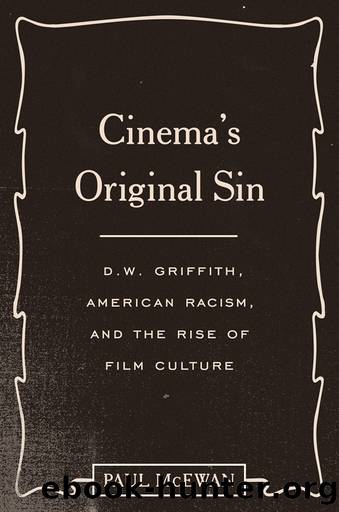Cinema's Original Sin by Paul McEwan

Author:Paul McEwan
Language: eng
Format: epub
Publisher: University of Texas Press
Published: 2022-01-15T00:00:00+00:00
Figure 4.2. Letter from Joseph Breen to Harry Aitken, October 1948 (courtesy of Trexler Library, Muhlenberg College).
All of this discussion of censorship takes place in an environment in which films were still subject to the Mutual decision of 1915 and thus could not claim an exemption from censorship on First Amendment grounds. At the same time, the Production Code of 1934 provided stricter limitations on films than almost any local or state law. A 1948 letter from Production Code director Joseph Breen to Griffithâs producer Harry Aitken (who was still administering the film in the late 1940s) assured him that The Birth of a Nation was exempt from the Production Code and that âextremely few film masterpieces are in this special category and then only in the original versions.â In the same letter, Breen also said the film was âan important part of the documentary history of the motion picture industry, and as such should be preserved intact.â27 It is important that he refers to the film as a âpart of the documentary history of the motion picture industryâ and not a document of American history. Breen is making it clear that the film is now an artifact of film history and outside of midcentury concerns about morals and censorship. This placement of the film as part of âfilm historyâ would begin to have important ramifications for the reception of the film in the 1950s.
THE RISE OF FOREIGN FILMS IN AMERICA
In this same period, the range of films available to Americans was changing in important ways. The success of Roberto Rosselliniâs Rome, Open City in 1946 helped to create a market for other Italian neorealist films, and in their wake came a great expansion in the market for foreign films in America, or at least the foreign films that could be conceived of as art films. Throughout the 1950s and 1960s, films arrived in waves from Britain, Japan, France, Scandinavia, and Eastern Europe.28 Often not submitted for Production Code approval because the theaters that showed them were not bound by the code, they could offer access not only to more complicated ideas and ideologies, but also to sexual images not found in Hollywood releases. Even after the controversy around Rosselliniâs The Miracle destroyed the legal foundation of the Production Code, the studios continued to use it for the next decade and a half, although its strictest rules were gradually weakened. After the code was abandoned completely in 1968 and Hollywood liberalized its standards, foreign films would lose this competitive advantage, but in the 1950s it still helped them to draw audiences. It would be a mistake of course to ascribe the popularity of foreign films simply to sex appeal, since the majority of them contained no sex or nudity whatsoever. It was clear that tastes were changing for various reasons that are hard to quantify in and of themselves. The postwar GI Bill provided four years of college education for returning soldiers, and nearly eight million took advantage, so that the number of degree holders in the United States doubled between 1940 and 1950.
Download
This site does not store any files on its server. We only index and link to content provided by other sites. Please contact the content providers to delete copyright contents if any and email us, we'll remove relevant links or contents immediately.
Kathy Andrews Collection by Kathy Andrews(11767)
The remains of the day by Kazuo Ishiguro(8894)
Spare by Prince Harry The Duke of Sussex(5142)
Paper Towns by Green John(5141)
The Body: A Guide for Occupants by Bill Bryson(5031)
Industrial Automation from Scratch: A hands-on guide to using sensors, actuators, PLCs, HMIs, and SCADA to automate industrial processes by Olushola Akande(5027)
Machine Learning at Scale with H2O by Gregory Keys | David Whiting(4261)
Be in a Treehouse by Pete Nelson(3999)
Never by Ken Follett(3885)
Harry Potter and the Goblet Of Fire by J.K. Rowling(3810)
Goodbye Paradise(3763)
Into Thin Air by Jon Krakauer(3349)
The Remains of the Day by Kazuo Ishiguro(3348)
Fairy Tale by Stephen King(3308)
The Cellar by Natasha Preston(3299)
The Genius of Japanese Carpentry by Azby Brown(3255)
120 Days of Sodom by Marquis de Sade(3227)
The Man Who Died Twice by Richard Osman(3041)
Drawing Shortcuts: Developing Quick Drawing Skills Using Today's Technology by Leggitt Jim(3038)
